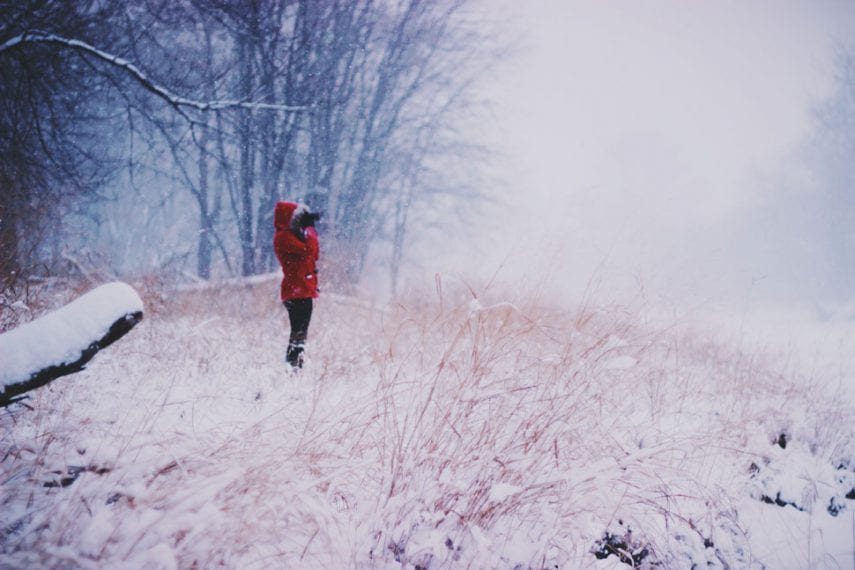When Skies Are Grey: Making A Plan For Seasonal Depression Treatment

Fall is already in the air and the days are getting shorter. My horse’s winter coat is starting to come in, my dog is no longer longing to jump in the lake, and the giant maple tree that has shaded the garden all summer is shedding its foliage all over my backyard. For me, the chill in the air, the early darkness, and the turning leaves don’t just signal a change of season, they also introduce a change in mood. The drop in temperature creates almost a mourning, a consuming and visceral sadness for what I fear will come. Too many of my winters have been spent in darkness—not just that which falls by 4pm in December, but the internal kind that prevented me from leaving the house for months on end, cost me jobs, and left me unable to complete the most basic tasks of living. As someone whose bipolar disorder has a seasonal component, winter means withering, and despite the fact that I am now well, stable, and high-functioning by any standard, the connection between the season and depression is rooted so deeply that my body remembers it automatically at the first rush of cold air, the first bare tree, the first morning frost. Now is the time for me and others who suffer from Seasonal Affective Disorder to make plans for how to stay healthy this winter and implement lifestyle changes that complement our bipolar and depression treatment.
Begin Your Recovery Journey.
877-727-4343Seasonal Affective Disorder As A Specifier
Seasonal Affective Disorder (SAD) is a fairly well-known mental health condition in which seasonal changes, particularly late fall and winter, produce depressive symptoms. SAD is theorized to be caused by the lack of sunlight, which can disrupt your natural circadian rhythm, reduce serotonin levels, and alter your body’s natural melatonin production. This condition is sometimes minimized with names like “the winter blues,” but it can be a serious medical ailment that greatly reduces your ability to function and produces painful emotional and behavioral symptoms. However, SAD is not a discrete mental health diagnosis, but rather a “specifier” that describes the seasonal presentation of depressive episodes in people with major depressionand bipolar disorder. It is estimated that 10-20% of people with major depression and 15-22% of people with bipolar disorder experience this seasonal pattern. The problem is particularly pronounced amongst people who live in northern climates where winter means drastically reduced sunlight, but even people in areas that experience less dramatic seasonal changes can be affected. If you know that you experience Seasonal Affective Disorder, you can minimize your chances of relapse by integrating specialized therapies and lifestyle changes in the fall and winter months.
Light Therapy
Light therapy uses intensive lighting many times more powerful than normal interior light bulbs to simulate sunlight and regulate brain activity. You sit in front of the light for 15-30 minutes each day while going about your normal activities like eating, reading the paper, or catching up on emails. People with major depression are typically advised to use light therapy in the morning, while people with bipolar disorder may use it either in the morning or midday. Research suggests that people with bipolar disorder may be more sensitive to morning light, increasing the risk of manic or mixed states, but can have success using their lights later in the day. Therapeutic lights can be purchased online or at some drug stores and pharmacies.
Change Your Working Hours
You want to make the most of limited natural light and sitting in an office isn’t the way to do it, particularly if you work in a dark or poorly lit environment. If possible, alter your work hours to allow you to spend as much time as possible in the sun. Even shifting your schedule by an hour can make a big difference. For many, this falls under reasonable accommodation and your doctor can provide supporting documentation confirming your need for changed work hours.
Spend Time Outdoors
When you are working, make a point of leaving the building on breaks and at lunch to take a walk outside. Try to get as much outdoor time as possible to take advantage of the positive effect sunlight has on your emotional and physical health; even in gloomy weather, getting outside can have a big impact. If you really want to make the most of winter, take up a seasonal sport like skiing, ice skating, or snowshoeing. But even just a hike through a forest preserve or walk around town can help you clear your mind and experience the benefits of both exercise and daylight.
Travel South
If possible, plan a trip to a warmer climate. Taking vacations is important for rejuvenating the mind and body, and for people who suffer from seasonal depression it can be profoundly therapeutic. Some people plan extended travel to optimize their health during winter months, but even a quick weekend getaway to a southern destination can give you the benefit of sun exposure, warmth, and relaxation. Planning the trip can also give you something to look forward to on dreary days.
Maintain A Schedule
One of the ways fall and winter cause SAD is by disrupting the natural circadian rhythms and melatonin production that regulate your sleep pattern, causing serious emotional and physical distress as your body struggles to compensate for a loss of stability. In order to encourage psychological health, make a schedule for yourself and commit to it. This includes adequate sleep, healthy eating patterns, work, and leisure time. Exercise can be a particularly important part of your routine to increase serotonin production and improve sleep quality.
Call for a Free Confidential Assessment.
877-727-4343Stay Social
Many people, even those without depressive episodes, can socially hibernate in the winter. It’s cold, there’s snow on the roads, you don’t want to drive or bundle up to wait for a bus or walk to the subway. However, this is the time when you are most vulnerable to the damaging effects of isolation and your social support network can play a critical role in maintaining emotional stability. Not only is social interaction good for you emotionally, it also has physiological effects that contribute to physical well-being.
Stay In or Connect with Treatment
If you are doing well with your current treatment, stick with it. Talk to your doctor or therapist about any fears you have regarding the change of season and discuss how you will deal with depressive symptoms. Knowing that you have a plan and professional support can give you a sense of relief from worry and reassurance that you will get through it. If your depression has escalated to the point where your current treatment is no longer effective, it may be time to seek out more intensive intervention. Bridges to Recovery’s comprehensive residential treatment program offers innovative, holistic bipolar and depression treatment for people with SAD in an intimate, supportive environment. With two beautiful and relaxing facilities in the Los Angeles area, you can escape winter and begin your healing process with the finest clinical care available while enjoying the nurturing benefits of Southern California weather.
Bridges to Recovery provides the highest quality treatment for people living with major depression and bipolar disorder using multidisciplinary, evidence-based therapies. Contact us for more information about how we can help you or your loved one start on the road to wellness.






